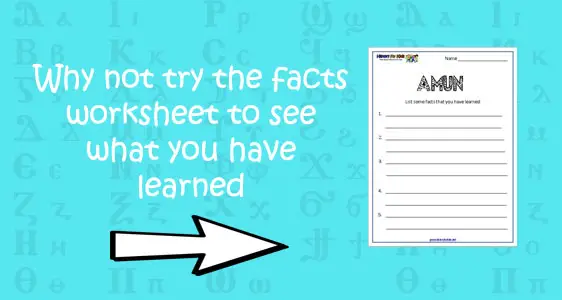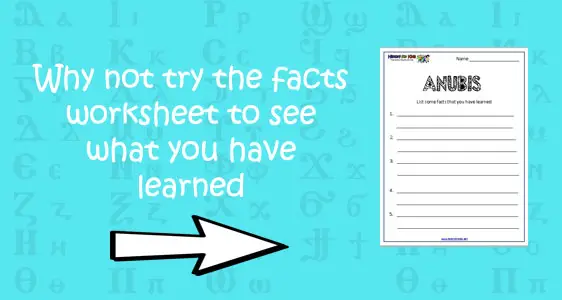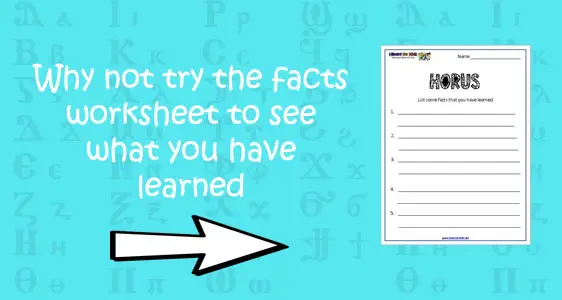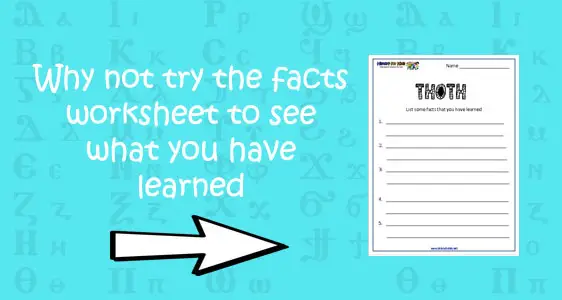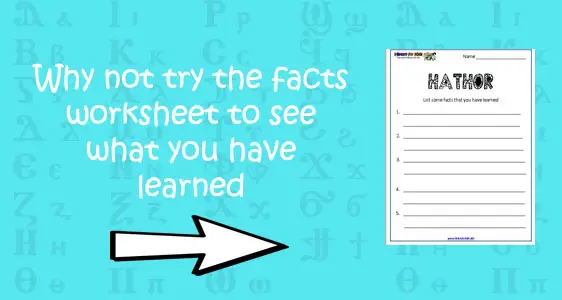Egyptian Gods
The ancient Egyptians worshipped so many gods and goddesses that it would certainly be hard to count all of them! You’ll be counting for ages, trying to figure out who they all are.
To help make it easier for you, we’ve put together an introduction to the ancient Egyptian gods and goddesses so you know who some of the most famous gods and goddesses were.
Amun

Amun was the ancient Egyptian god of the air, sun, and sky. Amun was originally a local god, and then he became a member of the eight gods collectively called the Ogdoad of Hermopolis.
He then became a member of the three gods referred to as the Triad of Thebes. During the New Kingdom, Amun became the national god of Egypt, and the head of the state pantheon merged with Ra, the sun god of Amun-Ra.
He was so important that he was also merged with the fertility god, Min, to form the god Amun-Min.
He is shown in a number of ways, as a ram-headed man, a frog-headed man, and most commonly as a man with a double-plumed crown.
Amun God With Blue Skin
Now that would be weird…having blue skin. Can you imagine what you would look like? Well, Amun who as we know was the Egyptian god of the air, sun, and the sky was originally shown with red-brown skin.
However, there was a religious revolution involving the god Aten, and Amun’s cult came back to life he was painted with blue skin, symbolizing his association with air and creation.
Atum in Ancient Egyptian History and Religion
As the religious beliefs and culture of the Egyptians developed some of their ancient gods were absorbed into each other to form new gods. The practice of creating new gods by combining them with old gods was called ‘syncretism’, which meant the blending of religious beliefs and practices to form a new system. Atum was first worshipped as a minor, local god. He then became a member of the eight gods collectively called the Ogdoad of Hermopolis.
Amun and the Ogdoad of Hermopolis
Religious cults were the basis of Egyptian religion. The names of the cults represented the number of major gods worshipped in the cult and the location of the cult center.
The Ogdoad of Hermopolis (Khmunu) had 4 female-male pairs of water gods, the goddesses in the form of snakes or cobras, and the gods as frogs.
- The word ‘Ogdoad’ means eight
- The eight gods, the Ogdoad, were worshipped in Hermopolis, during what is called the Old Kingdom, between 2686 to 2134 BC.
- The names of the gods and goddesses came from the same names
- Each pair represented the female and male aspect of one of four concepts of creation
Symbols of Amun – The Amun Crown
The symbols of Amun were the Amun crown and the ram-headed sphinx. The Amun crown had a flat-topped cylindrical crown base that was topped by tall, double ostrich feathers. The ostrich was a symbol of creation and light.
Symbols of Amun – The Ram-Headed Sphinx
The ram-headed sphinx is a strong symbol of fertility and Amun is sometimes referred to as ‘lord of the two horns’. The road to the Temple of Amun in ancient Thebes (now Luxor) was lined with ram-headed lion sphinxes, each one guarding between its front legs a statue of the pharaoh. There were 900 statues of the ram-headed sphinx at Thebes.
The ram heads represented Amun and were shown with the body of a lion (never winged), the hooves of a ram or a goat, and the head of a ram. The ram-headed sphinx is called a criosphinx whereas the human-headed sphinx is called the androsphinx. Now those are some words to try and wrap your head around! Bet you learned something new.
So now you know all about Amun, the powerful Egyptian god! Have we left anything out that you know? Share it with us.
Anubis

Have you ever heard of Anubis? Well, you might of, as he was a very famous god in ancient Egypt. He was linked to the mummification process, where bodies were preserved, as well as the journey to the afterlife.
Interesting Facts about Anubis
- Anubis was the Greek name for ‘man with a jackal head’.
- Anubis was shown as having the head of a jackal, the tail of a lion, and the body of a human. Sometimes drawings showed him as a full jackal. He was often seen with a golden tie or necklace.
- The skin of Anubis is often seen as very dark black or with a tinge of red. His flesh is a representation of the earthy energies with which he is connected. The color of his flesh is similar to that of the dark soil along the Nile. This rich, fertile soil was highly prized and gave the ancient kingdom the name Khem, which means ‘The Black Land’. The color of Anubis could link him to Osiris, whose green flesh represents the fertile fields.
- Now, this is pretty gross. In ‘The Book of the Dead’ Anubis is shown to be weighing a heart, during a ‘Weighing of the Heart ceremony. What a strange ceremony to have!
- The heart was measured against the feather of truth and justice, which belonged to Maat. If the heart was heavier than the feather, they were guilty and bad. These people were sent to Ammit, who was a lady demon with a body that was part lion, part crocodile, and part hippopotamus. She would then eat them. She must have looked rather strange!
- He was the one who apparently invented the process of embalming, which is how bodies were preserved.
- When Egyptians were being mummified, the head embalmer, who took care of the dead, would often wear an Anubis costume.
- No one is quite sure who Anubis was the son of. In early ancient Egyptian myths, he was said to be the son of Ra, but in later myths, he was the son of Set and Nephthys. There are other myths too, which say that he was the son of Osiris. Wonder which one is true…that’s quite confusing.
- Imagine receiving a gift of someone’s organs. That would just be weird. Apparently, when Osiris was killed by Set, Anubis received his organs as a gift. Wonder what he did with them.
- His wife was called Anput and his daughter, the goddess Kebechet, was associated with purification and washing away of dirt and decay.
- Anubis’s jackal head was often shown to be black. The reason for this was to show his link to death.
- There was another ancient Egyptian god called Wepawet. Strangely enough, he also had the head of a jackal. He was originally a god of war and was often confused with Anubis. Apparently, they got to know each other over time. In some myths, people believe that Wepawet was the son of Anubis.
- There were many symbols that were associated with Anubis, including flags, jackals, ox-hide hanging from a pole, and also embalming equipment.
- The reason that Anubis was given a jackal head was that jackals would often be found around tombs and graves.
- Prayers to the god Anubis are found carved on the most ancient tombs in Egypt.
- Apparently, his mother, Nephthys, left her son exposed to the elements. Instead of dying, he was found by Isis, who then raised him. He became a faithful helper to Isis.
- After Set had killed Osiris and scattered his remains, Anubis helped Isis and Nephthys to rebuild his body.
What was Mummification?
Mummification was very skilled work…you had to be really good at what you did. It took weeks to complete. This is a bit gross, but it’s what happened. First, the organs were removed, except for the heart. The body was then covered in salt and left to dry for about 40 days. After being washed, the dried body was stuffed to keep its shape. Finally, it was oiled and wrapped in layers of linen bandages. Not sure how cool a job this would be!
Anubis was a strange-looking god, but a powerful one too. It was best to live a good life and be honest otherwise he would send you to be eaten. How scary!

Horus

Horus was the Egyptian god of the Sky. That must have been a cool job to have! He was the son of Isis and Osiris. After fighting his uncle Seth, he became the king of Egypt. During this fight, he lost his eye.
That must have been one mighty fight! The Eye of Horus became one of the most important symbols in ancient Egypt.
What was The Eye of Horus?
The Eye of Horus was a powerful amulet, which is an ornament or small piece of jewelry that was thought to fight off evil, danger, and disease.
It was a sign of protection. It was also called the Wadjet Eye. The ancient Egyptians worshiped Horus partly because he had the Eye of Horus.
When he lost his eye, it was said that it grew back to become the Eye of Horus. Can you imagine losing an eye and then it growing back? Whoa, that must have been weird.
What did Horus Look Like?
Horus was considered to be very handsome. He was normally shown as a falcon or a falcon-headed man, although sometimes he appeared as a falcon-headed crocodile.
That’s a weird combination! Sometimes he would take the form of a heavenly falcon with his left eye being the moon and his right eye is the sun, his speckled breast feathers were the stars and the down sweep of his wings created winds.
He was also sometimes shown with a copper knife. Wonder what he used that for. He also normally wore the double crown to show that he ruled all of Egypt and to show that he was related to the Pharaoh.
How was Horus Worshipped?
Horus was worshiped all over Egypt, especially in Pe, Bendet, and Khem, ancient Egyptian towns. There were heaps of falcon gods before Horus, but eventually, Horus symbolized all of them.
In Upper Egypt, which was the south, in the town of Edfu, there was a temple in Ptolemaic, which was just for Horus. In Kom Ombo, there was another temple for Horus called the Kom Ombo temple.
Horus was a good friend of Sobek. He was also worshipped as a guide to the pharaohs. He sure seemed important with all those temples for people to worship him.
What was Horus’ Purpose?
As we said, Horus was the god of the sky. The pharaoh ruling at any given time of Egypt was always the living image of Horus.
When he died, that pharaoh became Osiris, the god of the dead and the father of Horus. The new pharaoh became Horus. He was there to protect the pharaoh.
He was a protector god, who was a god who fought evil. He was all about justice and honesty. He fought with Seth.
He did this to even the score for his father, Osiris, who was killed by Seth. When Horus beat Seth, he conquered his father, Osiris’, throne, and became a protector.
Interesting Facts about Horus
- Horus was certainly one important god as he was worshipped right from the very beginning of the ancient Egyptian period, right through to the end. As time went by, his jobs often changed over time.
- It’s a popular belief that he was the son of Isis and Osiris, but one ancient Egyptian myth says that Hathor was his mother. Other myths say that he was the son of Nut and Get and that Osiris, Isis, Set, and Nephthys were his brothers and sisters. Wonder which myth is true?
- For most of the ancient Egyptian period, the Egyptian Pharaohs believed that they were Horus in a human form. Wow, he sure was popular.
- The symbol of the Eye of Horus was often painted on boats to protect them from shipwrecks and storms too.
- His name means ‘he who is the sky’ or ‘the distant one’.
Hope you’ve found these facts about Horus helpful. Maybe you can use them for a school project or just wow your friends and family with all this knowledge.
Ra

Discover the legends and myths and religious beliefs that surrounded Ra, the very important Egyptian sun god.
There were lots of other Egyptian gods that were often linked to him, such as Atum and Horus.
Ra was usually shown in human form with a falcon head, crowned with the sun disk encircled by the Uraeus, the sacred cobra.
The sun itself was taken to be either his body or his eye. Ra was believed to traverse the sky each day in a solar barque and pass through the realms of the underworld each night on another solar barge to reappear in the east every morning.
Ra was also considered to be an underworld god, closely associated with Osiris as Ra resurrected Osiris to rule over the dead. In this capacity, he was depicted as a ram-headed figure.
Ra in Ancient Egyptian Mythology – The Sun Gods
Ra, the Egyptian sun god, was a very old god but there were even more ancient sun gods than him. As the culture of the Egyptians changed, so some of the gods were absorbed into new gods. Now that’s rather strange.
However, this way of creating new gods by combining them with old gods was called ‘syncretism’.
Do you think you can pronounce that? Syncretism meant that religious beliefs and practices were literally fused together to create a brand-new system.
Ra was associated with previous sun gods. Just to add to the confusion he was also referred to as ‘Re’!
As the ‘father of the gods,’ it was natural to the ancient Egyptians that every god should symbolize some form of him, and that he should represent every god. All the symbols and the myths as well as the looks of all the older gods were all mushed up together to form the new god Ra! How cool is that?
Because of this Ra was closely linked with the gods Atum, Horus, and other sun gods.
Ra in Egyptian Mythology
Ra starred in many stories, myths, and legends in Egyptian Mythology.
His main cult center was at Heliopolis, also called ‘sun city’, which is near modern-day Cairo.
Ra was said to have created himself out of the mound that emerged from the ancient waters. He then created Shu (air) and Tefnut (moisture), who then created the earth god Geb and the sky goddess Nut.
From Nut and Geb the gods Osiris, Isis, Nephthys, and Seth were born. Wow, that’s pretty cool.
Ra and the Pharaohs
The first ever mentions of Ra date all the way back to 2686 BC – 2181 BC. That was a seriously long time ago! Ra became so important that the Pharaohs took to calling themselves the ‘sons of Ra’.
He certainly was important for that to happen. He was worshipped far and wide. The Egyptian kings and pharaohs had special pyramids, obelisks, and sun temples built in his honor.
After his death, the Pharaoh was said to rise into the sky to join the people who followed Ra. During the period 2040 BC – 1782 BC, Ra was linked to more and more gods and combined with them. By 1570 BC – 1070 BC, the worship of Ra had become more complicated and people believed that Ra aged with the sun.
The walls of tombs showed Ra’s journey through the underworld carrying the prayers and blessings of the living with the souls of the dead on the sun boat.
What did Ra look like?
The pictures of Ra in ancient Egyptian art are found in tombs, temples, manuscripts and hieroglyphics, artifacts, and relics of ancient Egypt.
This is how he was shown in the ancient drawings.
- He was often shown holding the Ankh, the key of life, which represented eternal life and the ‘Was Scepter’ a symbol of great power and authority.
- His crown, or headdress, of the sun disk, symbolized the sun and was usually encircled by the Uraeus, the sacred cobra, a very strong emblem of royalty and authority. He sure was very, very important.
- He is sometimes also shown with the head of a ram that always had the sun disk on top of it, and this showed his role as a god of the Underworld
The Eye of Ra
Ra was also part of the myth that related to the all-seeing Eye of Ra and the Eye of Horus. The right eye of Ra represented the sun, and the left eye represented the moon.
Ra, or Re as he’s sometimes called, was one mighty powerful god, that’s for sure. Do you know any other cool facts to share with us about him?
Thoth

Thoth was the God of knowledge, wisdom, and hieroglyphs. Weirdly enough he created himself, who knows how, so he had no parents! Wonder how he did that.
Thoth’s wife was Ma’at, the Goddess of truth and they had no children.
Being the God of knowledge and wisdom, Thoth gave advice to the Gods who battled in one of the 3 most important battles in Ancient Egyptian history. The first battle was between Ra, the God of the Son, and Apophis, the God of Chaos.
The second battle was Heru-Bekhutet against Set, the God of evil. Finally, the last battle was Horus against Set.
The Egyptian god Thoth is thought of as one of the most important of the ancient Egyptian gods.
He did many jobs in Egyptian mythology including maintaining the universe, settling arguments among the other Egyptian gods, and he judged those who would die. Bet you had to be really well-behaved around him.
The ancient Egyptians linked this powerful deity, or God, with many things which included the mind, science, logic, intelligence, knowledge, writing, and reason.
How did the Ancient Egyptians show Thoth?
- Thoth is usually shown as a human with the head of an ibis. An ibis is a long and slim bird with a curved beak. The curved beak apparently symbolizes the curve of the moon. That’s pretty awesome.
- He is sometimes shown as half baboon and half human or as a dog-headed baboon because the baboon was seen as a night animal just as Thoth was God of the Moon.
- He is often shown wearing a crown; often this is the Atef crown which was a tall hat with ostrich feathers and a gold disk on top. He is also often shown wearing the United Crowns of Upper and Lower Egypt (also called the Pschent crown).
Interesting Facts about the Egyptian God Thoth
- It is believed that he was responsible for the creation of the heavens and Earth and all that is in them. He sure was powerful.
- Thoth was originally regarded as a moon god but as time went by the Egyptians made him even more important.
- His main temple was in the city of Khmun. The Greeks later named this city Hermopolis Magna. What weird names!
- According to Egyptian mythology, he apparently wrote a lot, and all his writing was eventually put into a book called the Book of Troth. It apparently had all the secrets of the universe in it. Now that would be a cool book to read. Apparently, if you read it you would get awesome magical powers, but you would also be troubled by a life filled with disaster. Hmmm, maybe it wasn’t so cool to read after all.
- Thoth was said to be the inventor of hieroglyphic writing and the Egyptians believed he gave this to them as a gift.
- The ancient Egyptians believed Thoth was the secretary and counselor of the most powerful god, Ra.
- In Egyptian mythology, Thoth stood next to Ra, on Ra’s boat, on Ra’s nightly trip across the sky.
- Pharaoh Djehuty who ruled Upper Egypt around 1650 BC was named after Thoth.
Many ancient Greeks noticed that Thoth had several things in common with their god Hermes; both gods were involved with writing and magic.
This led some ancient Greeks to combine the two gods into one god that they called Hermes Trismegistus. Do you think you can pronounce that? It’s quite a tongue twister.
He was definitely a well-respected and cool god and everyone thought he was awesome. Do you have any other facts to share with us about this mighty powerful god? We’d love to hear from you.
Osiris

Osiris was the Egyptian god of death, the Underworld and Rebirth. He was murdered by his jealous brother Seth and became the lord of the Underworld.
He was well-known for his green coloured skin, the symbol of rebirth and regeneration.
He also had white clothing which was a sign of mummification. He also had a tall white, conical headdress called the Atef crown.
He was very closely linked to the Pharaohs of Egypt and carried the flail and the crook which were the symbols of power and kingship. He sure was very important.
Who was Osiris?
Besides being the Egyptian god of death, the Underworld and Rebirth, Osiris was also Isis’ helper, who was his sister.
His famous sons were Horus by Isis and Anubis by his other sister, Nephthys. Osiris is one of the most famous and easily recognised of all the ancient Egyptian gods.
He was shown as a ‘human’ god without the head of an animal. He also had a false plaited beard that was tightly knotted, plaited and hooked behind the ears.
Can you imagine yourself with a beard like this? Sounds rather strange.
The Heavenly Osiris
Throughout their history the ancient Egyptians all believed that Osiris was heavenly. The ancient Egyptians believed that Osiris died by the powers of evil, Apep, who was the eater up of souls.
Wow that sounds scary. After their great struggle he rose again and became the king of the underworld and the judge of the dead.
Osiris was placed in a very high position amongst the gods and was equal to and, even sometime more superior than the sun god Ra. He certainly was an important God indeed.
Myths about Osiris
The most famous legend about Osiris is about his death by his brother Seth. Osiris was the oldest son of Geb and Nut who were the first king and queen of Egypt.
Osiris became pharaoh after Geb and married his sister Isis. Seth was always jealous of Osiris and his super important role as king of Egypt.
The evil Seth tricked Osiris making him lie in a magnificent coffin as part of a game and then murdered him.
Seth cut his body to pieces, and threw the coffin into the Nile. That was incredibly cruel! His body travelled down the Nile and across the sea to the Phoenician coast, where it eventually rested at the foot of a tamarisk tree.
As the tree grew it surrounded Osiris and the coffin in its trunk.
Later, the tree was cut down by the king of Byblos and was used as a pillar in his palace. Isis got the pillar back and moved it to Egypt. Anubis, the son of Osiris, helped Isis and her sister Nephthys to rebuild his body and Anubis was in charge of the first mummification.
This ancient Egyptian myth explains why Osiris was the god of the dead and ruler of the Egyptian underworld. The ‘Raising the Djed Pillar’ ceremony was a sign of the rebirth of Osiris.
Interesting Facts about Osiris
- When he was captured by Seth and imprisoned in a tree, this symbolised the ‘Tree of Life’ which was connected to abundance and looked after the grain to make sure it carried on producing fruit.
- He was also associated with both the growth and the decay of vegetation.
- The ancient Egyptians believed that he disappeared in the winter taking the crops into the Underworld with him.
- His green face was connected to the life he brought to the ancient Egyptian people.
Osiris was one mighty god of Egypt and was loved by most. He was special and was worshipped widely. Are there any other facts that you know about Osiris that we may have missed out? Tell us all about it, we would love to hear from you.
Isis

One of the most famous gods of ancient Egypt was Isis. She was one of ancient Egyptians most important gods.
If you lived in that time, you would definitely have to respect her, that’s for sure! The ancient Egyptians built lots and lots of temples to honour her.
Did you know that lots of ancient gods in Egypt changed roles throughout the centuries?
Well they did and Isis changed roles many times indeed. Here are some super awesome facts about this goddess who was certainly rather famous!
Interesting Facts about the Egyptian Goddess Isis
- Isis was linked to many different things. She was mostly related to protection, healing, motherhood, children and nature. Sounds like she was a great goddess don’t you think?
- Now this is seriously interesting. The name Isis is actually the Greek version of her name! Wow, who would have thought that? Her actual ancient Egyptian name was either ‘Aset’ or ‘Iset’.
- We already said she was super important, and she certainly was. She was seen by the Egyptians as both a protector and mother of the Pharaohs.
- It is believed that she changed her role as early as 3,100BC. Now that was a long time ago. This period in time was called ‘Predynastic Egypt’.
- Isis was a member of a group of gods and goddesses called the Ennead. This group, which was worshipped at Heliopolis, an ancient Egyptian city, was made up of the nine original gods and goddesses of ancient Egypt. They were considered to be the most important gods and goddesses of this ancient civilisation.
- Apparently Isis was the daughter of Geb, the Earth god and Nut, the goddess of the Sky.
- According to legend she had a sister named Nephthys and two brothers Osiris and Set.
- Now this is a bit weird! Isis was said to have married her brother Osiris and together they had a son named Horus. Would you like to marry a brother or sister? We don’t think so…
- Like most of the gods that the ancient people of Egypt worshipped, Isis was believed to have supernatural powers. They believed she had the power to heal. There is one myth that says that the healed her son Horus from a nasty scorpion sting.
- One of the most famous legends of all time was where Isis’ husband, and of course brother, was killed by their other brother Set. He was apparently very jealous of them. There are quite a few myths about this, but the one that most people believe is that Isis brought Osiris back to life. How cool is that? She obviously loved him very much.
- The ancient Romans became a part of ancient Egypt, but Isis was still worshipped across the land by the Roman Empire.
- There has been evidence uncovered that shows that she was worshipped throughout the ancient world. This evidence was temples and engravings. She was worshipped far and wide, including Italy, Spain, Pannonia, Britain, Germany, Asia Minor, and Portugal. Wow, that is far and wide. She was one popular goddess.
How was the Egyptian Goddess Isis Portrayed?
Most ancient gods and goddesses were shown in different ways in drawings and carvings that were discovered. Read on to find out what Isis apparently looked like.
- Early art of Isis shows her wearing a long dress and wearing a crown which had the hieroglyphic symbol for a throne.
- She is often shown holding a symbol called the Ankh. It looks like a key and supposedly symbolises the idea of eternal life, just like being immortal. Imagine being immortal? It would be cool, you could have fun forever!
- Isis is also closely linked with a symbol called the Tyet. This symbol was linked to ‘welfare’, meaning health, or ‘life’ to the ancient Egyptians. The Tyet is also called the Buckle of Isis, Blood of Isis, and Girdle of Isis. It is sometimes spelled tiet, tet, and set. This symbol looks like the knot that was used to fasten the Egyptian gods clothing.
- Together with her sister Nephthys; Isis is shown on many ancient coffins. It was believed that these pictures of her on their coffin would help protect the dead against evil.
She was a powerful and respected goddess across many lands. Do you know any other facts about Isis that you want to share with us?
Seth

The Egyptian God Seth was also known as the god of chaos. According to popular Egyptian mythology it would certainly seem that he created plenty of mayhem and havoc.
Apparently Seth’s cult was one of the oldest in Egypt.
Some pharaohs honoured him and used his name as part of theirs during certain periods.
Who was the God Seth?
How the Egyptians saw Seth over time changed quite a bit. At first, they saw him as a valuable god. They believed he lived in the kingdom of the dead.
Egyptians prayed to him so that he could help their dead family members.
- After some time, the priests of Horus fought with Seth’s supporters. Some people believe that Horus’ followers conquered Seth’s followers. After that his role changed completely and he became the complete opposite of Horus. Guess he wasn’t loved as much anymore.
- The Egyptians saw Seth as the god of darkness, chaos and the desert. He became very unpopular and was an enemy to quite a few gods.
- He represented drought and as lord of the desert and drought, he was the enemy to everything that gave life. The Egyptians also saw him as a storm and war god.
- The Egyptians often related him with the colour red. They hated people with red skin and, sometimes, killed animals with red fur. Wow, he certainly was hated then!
What forms did the Egyptian god Seth take?
- The Egyptians usually showed Seth as a man with the head of a fantastic animal that they called the Seth animal. It had a pointed snout, tall, rectangular ears and a thin body like a dog with a long forked tail.
- Often pictures of Seth show him holding an ankh in one hand and a ‘was’ staff in the other. The ankh was seen as ‘the breath of life’ while the ‘was’ staff was a long staff with a forked bottom and the head of the Seth animal on top.
- He was certainly linked to many different animals and was sometimes shown as just one of them. These animals were the boar, the antelope, the crocodile and a donkey. Some even saw linked him to poisonous creatures like snakes and scorpions. In some myths, Seth took the form of a hippopotamus.
- Horus was seen as being completely different to Seth, but in different forms he was actually Seth’s brother and nephew. Now that’s pretty weird. Some legends said that Seth was the father of Anubis, but others say that Osiris was Anubis’ father.
Seth helped Ra the sun god
In some myths, Seth fought against Ra, but this wasn’t true in all myths. Some stories said that Seth helped Ra. In these tales, he was a warrior on Ra’s sun boat who protected the boat against Apophis, the chaos serpent. Wonder which myth is actually true. Guess we’ll never know for sure.
Worship of Seth
- The pharaohs really respected Seth and his power. Seth was one of the Two Lords (Horus was the other) who gave the king power and authority. Some pharaohs, like Seti I, were named after Seth. Other pharaohs used the Seth animal as part of their emblem.
- There were two rather large festivals that were associated with Seth. One was one of the five Intercalary days, which were the days right before the New Year began. These were the days when Osiris, Horus, Seth, Isis and Nephthys were born. The Egyptians honoured each of them on their birthday.
- The other festival was rather strange indeed. It was like a ritual where a pharaoh or a priest would spear a model of a hippopotamus. Then the people all cut up and ate a cake shaped like a hippopotamus. Do you think you can make a cake shaped like a hippopotamus? This festival was in honour of Horus’ defeat of Seth.
Interesting facts about The God Seth
- Seth was the God of chaos, darkness, the desert and drought.
- The Egyptians had a religion of contrasts, where gods were the opposite of other gods. Seth was the opposite of three other major gods, which were Osiris, Horus and Ra.
- There were two centres were Seth was worshipped, which were at Ombos and Avaris.
- He murdered Osiris, whose son, Horus, later beat him.
- The Egyptians associated the colour red with Seth.
- Two of his main emblems were a mythical beast (the Seth animal) and the ‘was’ staff.
Seth sure sounded like an interesting god, bringing chaos with him wherever he went! He was worshipped and he was also not all that popular at times too.
Do you have any interesting facts to share with us about Seth?
Sekhmet

Ptah’s wife, the Sekhmet Goddess, was called the “Great Lady, beloved of Ptah, holy one, powerful one.” She was both Ptah’s sister and wife too.
This was very common in Egyptian mythology. She is one of the oldest Egyptian Goddesses around, and one of the most powerful. Her son was Nefertum, who was the God of Sunrise.
Her name comes from the Egyptian word ‘Sekhem’, which means power or might. This is often translated as the ‘Powerful One’ or ‘She who is Powerful’.
It was probably best to stay away from this powerful goddess.
How was Sekhmet Shown?
- Sekhmet was normally shown with the body of a woman and the head of a lioness.
- Her headpiece had a sun disk on it, which linked her with the Ra, the Sun God. Her headpiece also had a uraeus, which means cobra, and she was often dressed in red.
- How she looked, as well as her name, which meant “to be strong, mighty, violent” definitely showed her character. She was very well-known for her violence and her power. This was one Goddess to keep away from, that’s for sure.
Interesting Facts about Sekhmet
- The Book of the Dead is believed to recognize her power with the use of the harmful forces of the sun’s heat. She was often called ‘Nesert’ which means the flame. She was also connected with the hot winds of heaven. Others believed that she was linked to the hot winds of the desert with her breath.
- Sekhmet was a goddess of war and always went with the king into battle. She used weapons like arrows, swift darts, and the fiery heat of her own body, which apparently came from the heat of the sun.
- She got the title ‘The Scarlet Lady’ as she loved blood so much. Gross! In fact, there were often celebrations and sacrifices offered to her to keep her happy after the war and the end of the destruction.
- It was thought that her power was great enough not only to help Osiris but at times to rule over him.
- Apparently, the Book of the Dead says that during times of storms and great floods she even had power over the great god of the underworld. Wow, she certainly was very powerful.
- Sekhmet’s father was apparently Ra himself. She had many aspects to her that connected her with the sun god.
- In early Egyptian writing, she was often called the Eye of Ra, which was supposed to have represented the god when he was forced to take action against his enemies and was spiteful and fierce, the traditional evil eye.
- Looking at the hieroglyph for this eye, people think that its power came from the fighting spirit of the uraeus (cobra) and the heat of the sun.
- When Ra sent Hathor out to get revenge for human beings mistreating him, he sent her in the form of Sekhmet, the lioness. Because these two goddesses were connected, it kind of makes sense that Sekhmet was linked to loads of other goddesses including Hathor, Nut, and Bastet. Bastet was a cat and apparently, this showed the gentler side of Sekhmet. So she could be gentle then…who would have known!
- Amenhotep III placed several hundred statues of Sekhmet in his temple.
- There were two small things about Sekhmet that didn’t really show her as being the violent goddess that she was. Firstly, she was often shown with an ankh when she was sitting, which is a sign of life, and secondly, she was also very well-known as a healer as she knew so much about magic and sorcery. Maybe she wasn’t that bad after all.
- If you were friends with her, and you would be lucky if you were, she would heal you. It would have been important to stay on her good side!
- She was often called the ‘lady of terror’ and the ‘lady of life’. How weird is that?
Maybe you can use some of these facts for a school project or just use them for fun and impress your friends. Have we missed out any important facts that you know?
Ptah

Ptah was the God of Creation and Craftsmen.
In the Book of the Dead, he was a master architect, and responsible for building the structure of the universe.
It was said that Ptah created the great metal plate that was the floor of heaven and the roof of the sky. He also built the supports that held it up.
Some creation legends say that by speaking the names of all things, Ptah caused them to be.
What did Ptah look like?
He was one of the most unique-looking gods.
He was shown as a bald-headed man, wearing a beard and tight-fitting clothing that looked like a mummy’s wrappings.
From the back of his neck a flower-shaped meaning, which is a symbol of happiness, hung. His hands came through the front to his clothing and he held a scepter.
It had 3 symbols on it which were the long pole scepter, which meant strength, the ankh, which meant life, and the djed pillar which meant stability.
It sounds like he looked rather strange indeed!
He was also often shown on the platform that was linked to Maat, who was all about truth and justice.
Ptah was called “Lord of Maat, king of the two lands, the god of the Beautiful Face in Thebes, who created his own image, who fashioned his own body, who has established Maat throughout the two lands.” Wow, that certainly is a mouthful, he clearly did a lot!
He was the son of Nun and Naunet, husband of Sekhmet and the father of Nefertum, and later Imhotep.
What was Ptah’s most Important Role?
He was mostly linked to being a creator, someone who makes things. He was described as the god “who has made all gods, men, and animals- he who has created all lands and shores and the ocean in his name ‘fashioner of the earth.’ ” He was the founder of intelligence and had ways to communicate his intelligence.
He was the god who spoke the words and the craftsman who built part of the creation. Because of this Ptah was the patron of everyone who created handicrafts and worked with metal or stone.
Egyptian creation stories say that Ptah made the other gods by first imagining them in his heart and then using his voice to breathe life into them.
He went on to create other creatures from metal, stone, and wood. He also created towns and religious shrines, as well as ceremonies for worship.
Who Else was Ptah associated with?
As time went on Ptah was linked with many other gods, especially Sokaris and Osiris.
Both of these gods were connected with death. His mummy-like dress made his role even clearer that he was responsible for the souls in the underworld. He was also thought of as Lord of the Year measurer of time, but timeless himself.
This means that he was eternal and born again and again, always resurrecting himself. He was responsible for using an iron knife in the underworld to open the mouths of people who had recently died.
This was done in the belief that it would restore the senses of the dead. Wow, that just seems crazy!
Worship of Ptah
Like most gods, he was also seen as the protector of people who worshipped him. Ptah was worshipped right throughout Egypt.
He was often worshipped under the name of Ptah-Seker-Osiris. This showed his link to the gods Seker and Osiris.
He was worshipped in a temple called the ‘Mansion of the soul of Ptah’ in Memphis, which was an ancient Egyptian town.
In Memphis, Ptah’s temple had a sacred bull known as Apis. Considered an incarnation or soul of the god in human form, the bull was Ptah’s oracle. An oracle is a priest or priestess.
Ptah certainly was an interesting god and looked rather strange. Do you have any other facts to share about Ptah? We’d love to hear from you.
Hathor

In ancient Egyptian religion and mythology, Hathor (also spelled Athor) was the goddess of love, fertility, beauty, music, laughter, and fun.
She must have been awesome to be around! Or was she? Besides being really important she was very complicated too. Read on for more.
How was Hathor Shown?
She was shown either as a cow or as a woman with cow’s horns with the solar disk nested between them.
The ancient worship of cows was probably the reason that the figure of Hathor was born. She is one of the oldest known gods of Egypt.
Interesting Facts about Hathor
- Hathor’s name means ‘House of Horus’. But why is this? There is an ancient myth in which Hathor stood on the Earth as a cow, so that her four legs became pillars holding up the sky, while her belly formed part of the sky. Horus, the sky god, would enter her mouth every evening in the form of a hawk and appear again each morning. How weird is that?
- Because of this myth, people often thought of Hathor as Horus’ mother.
- Later on, Hathor was thought to be the wife of Horus.
- They had a son named Harsomtus, also called Ihy or Ahy. He was worshiped as a god of music.
- Hathor and her son were often seen holding a sistrum, which was a rattle-like instrument that was believed to send evil spirits away! Now that was probably a cool thing to have.
- In the underworld, known as Duat, Hathor looked after the souls of the dead providing them with food. Now that was nice of her! Anyone who carried her clothing would be safe in the underworld, the place of the dead.
- She was very nice and nurturing looking after people all the time. As she had this kindness in her, people often linked her to Isis, the mother goddess, but Hathor was also all about destruction. Wow, she must have had a split personality don’t you think?
- According to one myth, the sun god Ra, in his old age, decided to punish humans for disobeying him. He sent Hathor out to sort it out and terrorize all the people.
- She was pretty wicked then and she killed so many people that Ra decided this wasn’t all that cool and believed that not all humans needed to be punished. The other gods flooded the fields with a very strong drink that was dyed with red ochre. Hathor drank the beer, thinking it was blood, and became so drunk that she stopped what she was doing! Oh dear, at least she stopped terrorizing everyone around her!
- She had plenty of shrines in her honor and was one of the gods worshipped at Heliopolis, an ancient Egyptian town. She was obviously very important.
- She was also very popular at one point, and loads of children were named after her. How would you like to be called Hathor?
- Her main temple was at Dandarah (Dendera). One of the most important festivals was to honor her birth, which was full of dancing and happiness!
- She became very closely linked to Isis, who eventually became far more popular than Hathor.
- Hathor was also closely linked to turquoise, malachite, gold, and copper. She was known as the ‘Mistress of Turquoise’ and the ‘Lady of Malachite’. She also looked after all the miners to keep them safe.
- The Egyptians used eye makeup made from ground malachite. It not only made them look good but it also was believed to fight eye infections. Wow. This was also closely linked to Hathor. She sure had many roles, didn’t she?
Hathor was a goddess that seemed to have very many personalities and was linked to many things. She was popular, but at the same time, she was rather vicious too. No wonder she was complicated!
Do you have any other facts on Hathor? Please share them with us.
Nephthys

Nephthys was the goddess of mourning in the Ancient Egyptian religion. She was also the goddess of night, rivers, sleep, and nature too. Wow, she sure had a few jobs on her hands.
She was a friend and protector of the dead. Nephthys were important in ancient Egyptian culture because the afterlife was highly valued in ancient Egypt. She always stood at the head of the coffin that would take the dead to the underworld with outspread wings.
Her Egyptian name was Nebt-het, which means ‘Mistress of the House’. The house that we’re talking about is the sky where Horus lived. Some people got this name confused and thought that she was a housewife, but that wasn’t so. Her name actually means ‘Mistress of the Enclosure’. This means she was like a priestess.
What did Nephthys Look Like?
She was always shown as a woman with the symbols for ‘basket’ and ‘house’ on her head. Sounds strange putting those two things together don’t you think?
Her symbols are a kite, a crow as well as bones and skulls. She was sometimes given wings in the form of a bird, making her a solar god as well as a god of the dead.
She was also often shown riding in a funeral boat that took the dead to the Blessed Land. She doesn’t look exactly like you would expect the picture of death to be, but she was definitely the closest to it in Egyptian belief.
Interesting Facts about Nephthys
Nephthys was very popular and was worshipped right throughout Egypt. But what’s different about her is that she had no formal temples like a lot of the other gods did.
Some myths say there were temples, but it is mostly believed that she had no temples.
- She was the sister of Osiris and Isis, and the wife of Seth, who was also her brother. They sure liked to do things differently in those days.
- She was one ancient Goddess as she was written about in the Old Kingdom writings.
- She was also the mother of Anubis and her mother and father were Seb and Nut.
- She was also known as the ‘Useful Goddess’. That’s a strange name; she must have been good at helping out!
- Even though she was quite popular, strangely enough, she was often ignored or pushed into the background. That’s not too cool.
- Now, this is interesting. She is normally shown as being good, loyal, and caring, but in some myths, she was shown as ferocious and dangerous, able to kill people with her fiery breath.
- Nephthys is always shown as a loyal friend to her sister Isis after Seth killed Osiris. Seth killed Osiris as Nephthys had a son from him. She helped her sister find Osiris’ body and rebuilt him to come back to life.
- This is how she became associated with the dead, and was a friend to them. She guided them and comforted their families. Now that was nice of her!
- She also comforted women in childbirth while standing at the head of their beds.
- Nephthys and her sister Isis were often together and you could only tell them apart by the hieroglyph on their heads. Also, like her sister, Nephthys was thought to have great magical powers – she was the ‘Mighty One of Words of Power’.
- Nephthys and Isis were opposites of each other, where Nephthys was associated with death and Isis was associated with rebirth.
- We’ve already seen that Nephthys had lots of names, but there are more…there sure were a lot
o Lady of the Body (of the Gods)
o Dweller within Senu
o Lady of Heaven
o Mistress of the Gods
o Great Goddess, Lady of Life
We hope you found this article interesting. Maybe it can help you with a school project.
Useful Websites
- Childrensuniversity – Find out about Egyptian Gods and try our challenge
- British Museum – The Gods and Goddesses of ancient Egypt
- Egyptian Museum Berlin – Home to one of the world’s most important collections of Ancient Egyptian artifacts

